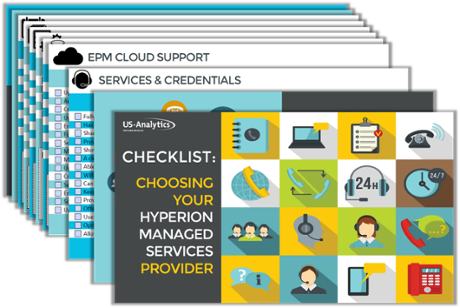Before getting started, you know your EPM project will be costly, take time, and tie up valuable resources. However, whether you’re upgrading, implementing a new solution, or moving to the cloud, there are steps you can take to ensure your projects are successful and money is well spent.
Your EPM tools are an important investment that will help optimize your processes and improve data consistency. The following tips will help you get the most out of that investment and ensure that you’re fully using your EPM tools.
Using Advisory Services
So what does an EPM advisor do, exactly? An advisory team can help you:
- Map your business needs and pain points to solutions
- Make sure your EPM/BI strategy is aligned with and supports your corporate strategy
- Gain the internal support your initiatives need from the beginning
- Focus on opportunities with the highest ROI
- Create momentum for your projects
- Ensure smooth change management with functional, technical, and executive stakeholders
- Anticipate risks and changing dynamics
- Stay on track with a strong vision and step-by-step roadmap
- Generate immediate ROI as well as long-term value
For example, if you’re an on-prem customer, you might ask an advisory team to recommend whether it’s better for your organization to upgrade or move to the cloud. EPM advisory services don’t just tell you which of these paths to take — it shows you how to get there successfully.
But what should these advisory services include? What should they identify? How will they help save money in the long run? In the following sections, we’ll go through some of the methods that an EPM advisor might use to make your project successful.
The Complexity Gap
Depending on the EPM consulting firm you use, this might be called something else. The complexity gap refers to the magnitude of change that’s expected from a project and your organization’s ability to embrace that change.
If the magnitude of change expected from the project is high and your organization’s ability to embrace change is low — you’re looking at a high complexity gap. The complexity gap will indicate the amount of time and budget that should be spent on a project, helping all parties set realistic plans for a successful project.
The Initiative Matrix
This tool is a simple two-by-two grid that can help you reveal a macro view of how your organization is trying to close its complexity gap and reach its business objectives. This exercise should:
- Ensure that your project addresses the problems you need it to solve
- Foster communication and ensure team buy-in
To learn more, download the initiative matrix.
The Roadmap
The roadmap helps you visualize the matrix. It shows you major initiatives by time-phased categories across logical rollout groupings. A roadmap can act as a blueprint, showing you key dependencies and what needs to be improved before starting your EPM project.
To learn more, download the roadmap.
Understanding Direct vs. Indirect Costs
When it comes to an EPM project, it can be difficult to navigate exactly how much everything will cost. The best thing to do is understand the direct costs vs. indirect costs.
Direct Costs
Direct costs can be completely attributed to your EPM project; they include things like acquisition and deployment. These are the costs that are easy to calculate before getting started with your EPM project.
Though there are multiple licensing models, software licensing is typically a cost that is easy to calculate and directly relates to your EPM project. Depending on the technology, you might be paying for a license per user, license per module, or a license per processor. For a cloud-based EPM product, you’re typically looking at licensing per user for a set amount of time.
For on-premises EPM products, you’ll also have to consider the cost of hardware needed to support your EPM environment.
Indirect Costs
Indirect costs can be fixed or they might vary. These costs aren’t directly accountable to your EPM project, but they help support your EPM tools, helping to optimize them and make your project a success. These costs might relate to administration, training, or other technologies that help support your EPM tools.
Some organizations might consider using a data warehouse to manage their data. To estimate the cost of a data warehouse, you need to consider:
- How much additional capacity is required for EPM in the data warehouse
- Personnel costs for maintaining the EPM side of the data warehouse
- Costs for building additional cubes and processes for EPM within the data warehouse
You’ll also need to consider data integration. Most likely, you’ll first integrate data from core systems and general ledgers, but organizations often choose to integrate their operational data as well.
Other indirect costs you’ll need to consider are:
- Personnel costs for running and administering your EPM tools
- Costs for building custom applications
- Post-implementation training costs
Utilizing Strong Project Management
On any EPM project, you need someone who will be a resource who's responsible for ensuring that best practices are being utilized. This person will monitor the progress of the project, ensuring that success criteria are being met while the project stays on time and budget.
It's important to choose a consulting firm that has experience with project management and can provide you with examples of similar and successfully completed projects. Besides utilizing a dedicated project manager from the consulting firm, you should also choose someone on your team to help manage the project. An internal project manager should be there to make sure the necessary internal team members are involved and help the EPM firm coordinate status updates.
Finding Support That Works for You
The ROI of your investment depends heavily on whether your systems receive proper ongoing care and attention. It’s important that you choose some sort of support, whether it be a in-house admin, a managed services provider, or a combination of both.
Finding the right support will save you money, time, and energy. You can ensure your system is proactively supported so things don’t go wrong, and if they do, you have someone on hand to fix things properly and right away.
To see everything you should be getting from your support team, download the checklist.







